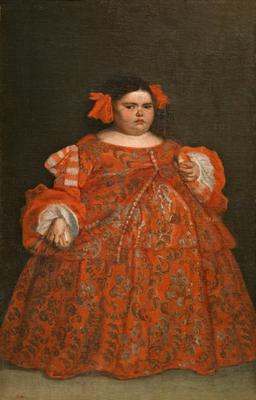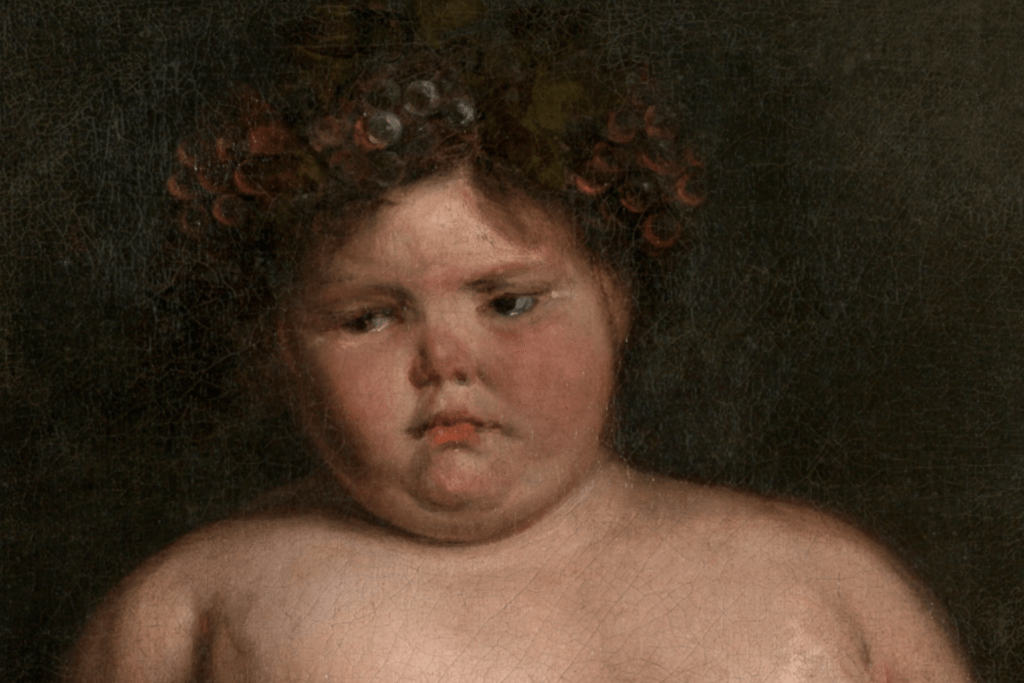
Born 1674 in Bárcenas, Spain, Eugenia Martinez Vallejo is known for featuring in two paintings by artist Juan Carreno de Miranda. Known for his portraits, the painter of baroque tradition was appointed court painter to the queen in 1671. However, he remained for a long time in the shadow of the very popular Diego Velazquez, who was one of his friends.
Painted in 1680, both of Eugenia’s portraits can be seen today at the Museo Del Prado in Madrid, where they are displayed side-by-side as a pair. However, calling her a muse would be wrong. Eugenia was brought at the age of 6 to the court of Charles II who ordered the works. There, she was exhibited because of her obesity as a curiosity or a ‘freak’. The dehumanising term was often used to refer to people with disabilities. As a matter of fact, it was common practice for aristocrats to take advantage of the disabled for their own amusement by exhibiting them as mere objects. One of the most famous examples of this is the painting Las Meninas, painted by Velazquez in 1656. The notorious painting features among the subjects Maria Barbola, who suffered from achondroplastic dwarfism. However, this was not an isolated case. Philip IV, who was the reigning king at the time, retained at the royal court around 110 people who suffered from dwarfism.
In Eugenia’s case, the painter goes as far as to refer to her as a monster. Indeed, the paintings are known as The Monster Clothed and The Monster Undressed. The latter portrait shows Eugenia posing naked and deprived of her humanity like a mythological creature. This often leads the painting to be subtitled Bacchus, who is the Roman God of wine, festivity, and insanity. In the other portrait, Eugenia wears a red and white dress which transforms Eugenia’s body into a grotesque shape. While the portraits are praised by art historians for presenting her with dignity, this couldn’t be farther from the truth. In fact, the paintings are very hard to look at and it is impossible to deny the darker reality which is so obviously at play. In the portraits, Eugenia appears highly sad and uncomfortable.

The girl, who came from a poor background, is said to have suffered from Prader-Willi syndrome. The genetic disorder, which usually appears in childhood, is accompanied by various physical complications. One of those symptoms is obesity as those affected often feel constant hunger. While many laws were passed to restrict the exploitation of disabled people, discrimination against obese people persists and still causes a lot of harm. This is unfortunately visible on the Prado’s website, on which we can find a presentation of the works. In the analysis, the institution decides to completely ignore the reality that is depicted. By doing so, they contribute to perpetuate the violence that is presented in front of our eyes. This is why it is so important to tell Eugenia’s story and change the narrative in order to help her regain the dignity she deserves and break the stigma.
-Claire Rochet
Contributor
Girl Museum Inc.

Poor girl. Monsters are those who submitted her to this.
Poor kid God bless you Eugenia
Just a correction. She was born in 1674, not in 1614 as stated in the first sentence.
Fixed! Thanks for catching that.
-Katie Weidmann
Editor-in-Chief
Your birthdate is wrong by 50 years, please check
Sorry, off by 60, or the painter’s birth year respectively
She was a beautiful girl no matter what her size, and she should’ve been treated with dignity and respect, and not like the freak they made her believe that she was. She deserved better. Thank you for sharing her story and taking steps to give her back her honor, dignity, and self worth.
I feel outrage, but I’m afraid that feeling is eclipsed by profound sadness for the child’s treatment.
Fat shaming has been around for a long long time – so awful
Unfortunately, way back then they did not have the education and the medically advanced knowledge we are privy to today. Bullying has been around since time immemorial and will probably also be around for a very long time to come yet.
As late as the early 20th century, people with genetic issues were still being used as circus curiosities. Thankfully now, it just wouldn’t wash with the public.
Look at it from the child’s POV…she had good food, a nice place to live in luxury and other people around her to play with as well as those to look after her. She probably had things like toys to amuse her as well….something she would never have had if she had lived all her live in a tiny little bedroom in an old poor persons house.
You are making a lot of assumptions. We don’t know if she was treated well. What we do know, however, is she was called a monster, ridiculed for her weight, and treated as a sideshow act. Don’t make excuses for how horribly this poor child was treated. It was just as wrong then as it is now.
Then why does she look so MISERABLE in every painting ?
Juan Carreño de Miranda actually felt for her — see the tears in her eyes that he didn’t hesitate to paint. We can witness her suffering centuries after.
Does anyone know what happened to her after these portraits were done? She died in 1699, so she lived to age 25.
How tragic! Is there any further information on the life of Eugenia?
You are making assumptions about the artist and model you know nothing about. Would it be better if Eugenia had been ignored, never painted? She would have died forgotten and unknown. Is would it be better if Velasquez forbid Maria Barbola from being in the room while he painted. Both of these people– Eugenia and Maria Barbola– are painted with humanity, in my opinion. Maria Barbola is treated as any of the other subjects in the painting– she’s not made into a caricature. She had dwarfism; she was painted as having dwarfism.
Eugenia is painted with sadness in her eyes. She may have lived with sadness in her eyes and the artist didn’t ignore it. Her life may have been sad, as so many lives were/are sad. Had he chosen not to paint her, you wouldn’t even know this poor girl existed– her plight in life would have been ignored, and she’d not even be a memory.
My thoughts: The palace at least could afford to make clothes for her and feed her. She must have found some type of community and love with the other disabled people that were kept there. She most probably received some type of (medical?) care to have lived until 25. So many questions unanswered. The king was so sick himself…I’d like to think she was left alone for the bulk of her life.